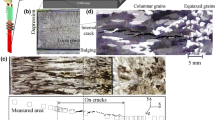Abstract
A procedure has been established to measure the relationship between void growth, plastic strain and stress triaxiality during the fracture of a C-Mn structural steel. A calibration factor for void growth was determined using the smooth tensile specimen tests and pre-cracked side-grooved three-point bend bar tests. The factor was expected to be applicable over a rather wide range of the constraint generating geometries.
The experimental void growth relation shows a real void growth rate in the structural steel which is smaller than that determined by the Rice-Tracey's void growth theory for stress triaxialities,\({{\sigma _m } \mathord{\left/ {\vphantom {{\sigma _m } {\bar \sigma }}} \right. \kern-\nulldelimiterspace} {\bar \sigma }}\) larger than about 1.2. However, when the\({{\sigma _m } \mathord{\left/ {\vphantom {{\sigma _m } {\bar \sigma }}} \right. \kern-\nulldelimiterspace} {\bar \sigma }}\) value is smaller than about 1.2, the void growth predicted by the Rice-Tracey's theory tends to slightly underestimate the void growth in the steel. The variations of the plastic strain and relative void volume have been measured and evaluated ahead of the blunting crack tip in the pre-cracked side-grooved three-point bend specimens at the point where the ductile tearing initiated. These results are related to theories for the level of triaxial stresses.
Résumé
On a mis sur pied une procédure pour mesurer la relaxation liant la croissance des lacunes, la dilatation plastique et l'état de triaxialité des contraintes au cours de la rupture d'un acier de construction au C-Mn. La croissance des lacunes a été étalonnée en recourant à des essais de traction sur éprouvettes lisses et à des essais de flexion en trois points de barreaux entaillés latéralement et préfissurés. Le facteur d'étalonnage tiré de ces essais devrait être applicable à une large gamme de géométries produisant une concentration de contraintes.
L'expérience a montré que, dans l'acier de construction étudié, la croissance des lacunes est plus faible que ne le laisse prévoir la théorie de croissance de Rice-Tracey, dans le cas de triaxialité de contrainte a. 16 supérieure à environ 1,2. Par contre, lorsque cette triaxialité est inférieure à 1,2, la croissance de lacunes est légèrement sous-estimée par le théorie de Rice-Tracey.
On a mesuré et évalué, dans les éprouvettes de flexion pré-fissurées, les variations de déformation plastique et de volume relatif de vide en avant de l'extrémité d'une fissure en cours d'ouvertures et ce dans la zone d'amorçage de l'arrachement ductile.
Les résultats sont en relation avec les théories fixant le niveau de triaxialité d'une sollicitation.
Similar content being viewed by others
References
C.A. Berg, inProceedings of the 4th U.S. National Congress of Applied Mechanics, 2, ed. R.M. Rosenberg (1962) 885–892.
F.A. McClintock,Transactions ASME, Series E, Journal of Applied Mechanics 35 (1968) 363–371.
J.R. Rice and D.M. Tracey,Journal of the Mechanics and Physics of Solids 17 (1969) 201–217.
T.B. Cox, and J.R. Low, Jr,Metallurgical Transactions 5 (1974) 1457–1470.
M. Perra and I. Finnic,Fracture, ICF4, 2 (1977) 415–423.
F.M. Beremin,Advances in Fracture Research, ICF5, 2 (1981) 809–816.
Yeo-Wu Shi, PhD Thesis, The University of Aston in Birmingham (1982).
J.C. Lautridou and A. Pineau,Engineering Fracture Mechanics 15 (1981) 55–71.
D.A. Shockey, K.C. Dao, L. Seaman, R. Burback and D.R. Curran,Computational modelling of microstructural fracture processes in A533B pressure vessel steel, NP-1398, Final Report, EPRI (1980).
J.W. Hutchinson,Journal of the Mechanics and Physics of Solids 16 (1968) 337–347.
J.R. Rice and G.F. Rosengren,Journal of the Mechanics and Physics of Solids 16 (1968) 337–347.
V. Kumar, M.D. German, and C.F. Shih,An engineering approach for elastic-plastic fracture analysis, NP-1931 EPRI (1981).
D.A. Curry and P.L. Pratt,Materials Science Engineering 37 (1979) 223–235.
J.T. Barnby and M.R. Johnson,Metal Science Journal 3 (1969) 155–159.
C.F. Shih and M.D. German,International Journal of Fracture 17 (1981) 27–43.
R. M. McMeeking,Journal of the Mechanics and Physics of Solids 25 (1977) 357–381.
Author information
Authors and Affiliations
Rights and permissions
About this article
Cite this article
Barnby, J.T., Shi, Y.W. & Nadkarni, A.S. On the void growth in C-Mn structural steel during plastic deformation. Int J Fract 25, 273–283 (1984). https://doi.org/10.1007/BF00963462
Received:
Revised:
Issue Date:
DOI: https://doi.org/10.1007/BF00963462




